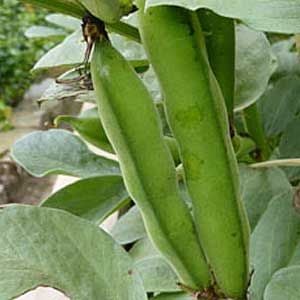
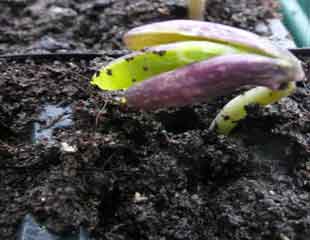
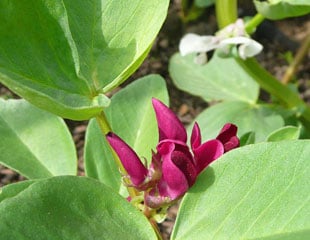
How to Grow Broad Beans
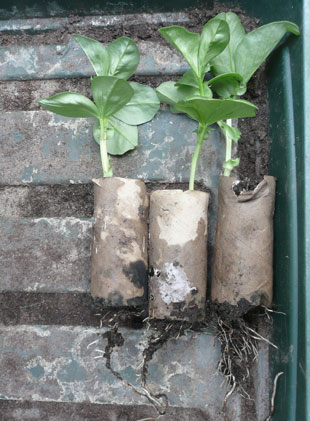
I realise Broad Beans are a bit of a marmite vegetable, love them or hate them, but I love them and they are so easy to grow. Broad beans crop early in the year and it is possible to plant a quick crop in the soil afterwards such as rocket, radishes or cut and come again lettuce. Equally, during a good summer, you can get a second, smaller crop of beans if you want to leave the plants in the ground for longer.
You need a good number of plants for a decent crop and germinating from seed is the most economical way to get a large crop. Broad beans are a large seed, easy to handle and to germinate. Watch the video for tips on sowing broad beans and tips about planting different beans
Broad beans are the hardiest of the bean family to grow, quick to germinate within about 5-7 days of sowing, and they put on rapid growth, producing a crop around June /July depending on the growing conditions. The hardiness varies with the variety, but some autumn/winter sow broad beans are hardy down to -10 and will germinate in very low temperatures. This means if you are growing over the winter, Broad beans only need to be protected against harsh frost and snow.
However, broad beans do not do well over winter in a heavy, wet soil, but with the benefit of a well-drained soil, you can sow and grow Broad beans in the autumn. The best-known varieties for autumn sowing is Aquadulce Claudia' and the plants will overwinter. If your soil is heavy, wet, poorly drained or in an exposed area Broad beans are best sown in the Spring.
The image top right shows a bean flower, which although usually white this variety has attractive crimson flowers, and is simply called Broad Bean 'Crimson Flowering'.
How to grow Broad Beans from Seed
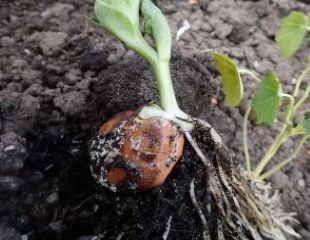
Broad beans are large seeds, easy to handle and quick to germinate.
You can start Broad Beans from late February onwards. Fill suitable containers, such as small pots, root trainers or toilet roll holders with compost, damp it and press down gently to ensure there are no air pockets and then place a bean seed about 7 cm down the container, sprinkle with a little compost and cover. It does not matter which way up you plant the seed, it will sort itself out.
Put in a warm place and germination should occur after a few days.
Broad beans are the hardiest of the bean family and can be planted out in March/April and sown direct into the veg plot from late March /April onwards, particularly in more sheltered gardens. Broad Beans will only require protection if there is severe weather.
Plant in double rows 30 cm apart, shallow about 7 cm deep, plant every 15cms.
What are the best containers for Broad Beans

Beans have long roots, and for this reason, sow seeds in deep containers. You can buy special containers called root trainers which are suitable for all legumes, see image below. They can be expensive and not all garden centres sell them. A more eco friendly non plastic alternative is toilet rolls holders, illustrated left. Broad beans (and all beans and peas can be germinated in toilet roll holders in which they will grow well until ready for planting out.
If you are growing Broad Beans in toilet roll holders, a tip is to take care when watering and avoid soaking the cardboard otherwise it may go soggy and collapse.
The left-hand image shows broad bean plants ready to plant out; their roots extend from the toilet roll holders in which they germinated.
How to Stake and Support Broad Beans
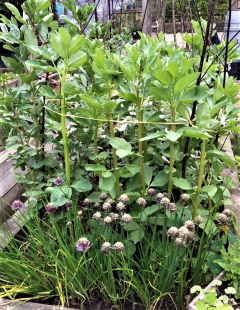
Broad Beans, unlike Runners or French Beans, do not climb, or cling and require support, as they have a tendency to flop over. The best way to do this is to make a corridor using string and cane/ wooden supports.
This works well and as illustrated left, the plants grow inside the string which provides support and stops them from flopping. Set the stakes about 1ft/30cms apart so you can plant a double row of beans and use the string tunnel to support the beans as they grow. This keeps the beans in check and is much better than trying to train up canes and wigwams, which are only suitable for Runners and French beans, and some peas.
Broad beans grow to a height of around 1.5 metres, (check packet for details) which means the can supports will need several layers of string. Broad beans have a tendency to splay outwards and need to be pushed back in within the string supports. As soon as the pods swell and you can feel the beans inside, they are ready to pick.
There are varieties of Broad Beans which are more upright in their growth, and I have grown Broad Bean 'Oscar' with no support and found it to be excellent.
Broad beans often suffer from black fly which cluster on the tips and new growth. To reduce this pinch out the top growth. It is the young tips which the black fly are drawn to.
Problems when growing Broad beans
How to prevent Black Bean Aphid
This can be a problem with broad beans and takes the form of black aphids on the soft growing tips of the bean plant. To prevent or ameliorate this problem, pinch out the tops as soon as the bean plant has enough pods. Avoid planting too close together, which is always tempting to get a higher yield but if planted too dense this limits air flow and will also encourage rust and chocolate spot see below.
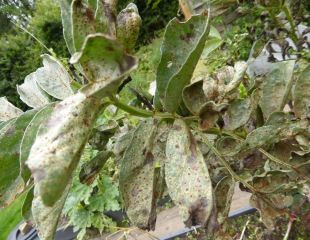
Rust and Chocolate Spot
When growing Broad Beans in wet conditions, there can be a problem with rust (small brown patches on the leaves) and chocolate spot (spreading brown patches) may occur, (see image) Rust is not too much of a worry, remove the leaves and battle on. Chocolate spot is a problem, as it can spread across the plants as quickly as you try to remove the leaves. It's a relative of Botrytis (a type of mould) and chocolate spot only affects Broad beans.
Related as it is to mould, damp will encourage it. If your conditions are on the wetter side, do not crowd the plants and space them out more generously to allow greater air flow. Broad beans will need watering in dry spells.
If you like a neat vegetable plot, here is a tip from a RHS garden, (who always have the tidiest vegetable plots ever). In the image below, instead of using canes and string, the RHS garden at Harlow Carr supports the Broad beans with twigs from spare prunings. Lots of plants do require support, twigs and branches look a lot nicer than canes, and they are free. See plant supports for free.
There are many other types of tasty beans to grow and all are easy green wheelbarrow : runner beans; growing beans and easy peasy peas.
How to get a second crop of broad beans
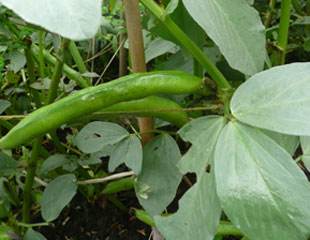
Broad beans are vigorous plants, and it's always worthwhile attempting a second harvest in late August or September, particularly if late summer and early autumn are warm and sunny. In July, cut down the plants from which you have harvested beans, and those whose foliage is looking tired, shortening it to around 20 cm. Leave a stalk in the ground. Within a short time, the plants will throw out fresh shoots, and if it's a reasonable summer, new flowers will appear and in due course produce a second crop, less vigorous, but still worth picking.
I took the picture in October while the plants were still producing a crop. Although the pods are smaller, the plant produced a light crop throughout September and into October.
After harvesting, cut plants down to ground level using the tops for compost, and leave the roots in for their nitrogen content.
Chocolate spot on Broad beans

Broad beans are usually trouble free but if is very wet, Chocolate spot can strike and makes a real mess of the crop.
Root trainers for Beans
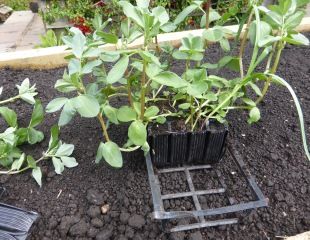
Broad beans grown in special root trainers to allow for a long root run. These are suitable for all types of beans and peas, including sweet peas.
Good Varieties of Broad Beans to Grow
Good varieties to grow, all of which are AGM (Award of Garden Merit) Aquadulce Claudia, The Sutton, Express, Imperial Longpod and the crimson flowering variety (not AGM) is simply called 'Crimson Flowered'
In 2017 I tried Broad bean 'Oscar' because it is described as being compact, and not requiring support, which would be a plus. It is a popular variety with commercial growers and freezes well. It performed well in what was a poor summer and I will definitely be growing it again.
Video How to plant and grow Broad Beans
More about growing Broad beans check out Suttons Bean Blog with a collection of good gardening advice.
